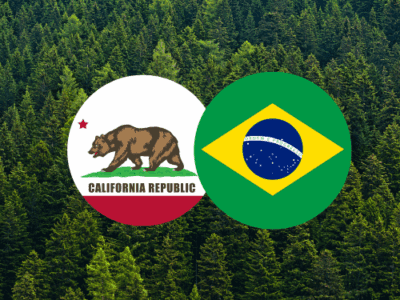Climate change affecting the U.S.
 The US Global Change Research Program has just issued a report on Global Climate Change Impacts in the United States. For people who have been paying attention, there’s not much new here. But this report, authored by a team of distinguished scientists from inside and outside the government, endorsed by the White House (see this White House blog post), and including region-by-region details, should help spread the word to others.
The US Global Change Research Program has just issued a report on Global Climate Change Impacts in the United States. For people who have been paying attention, there’s not much new here. But this report, authored by a team of distinguished scientists from inside and outside the government, endorsed by the White House (see this White House blog post), and including region-by-region details, should help spread the word to others.
It is already increasing popular media coverage of the need for climate adaptation. Both the Washington Post and the New York Times, to take only two examples, have covered the report’s release. And it should form the basis for future policy decisions. John Holdren, Director of the Office of Science and Technology Policy, and Jane Lubchenco, NOAA Administrator, have already said in transmitting the report to Congress and the President:
We intend to use the essential information contained in this report as we make policies and decisions about the future, and we recommend others do the same.
The report’s Executive Summary lists the following key findings:
1. Global warming is unequivocal and primarily human-induced. . . .
2. Climate changes are underway in the United States and are projected to grow. . . .
3. Widespread climate-related impacts are occurring now and are expected to increase. Climate changes are already affecting water, energy, transportation, agriculture, ecosystems, and health. These impacts are different from region to region and will grow under projected climate change.
4. Climate change will stress water resources. Water is an issue in every region, but the nature of the potential impacts varies. Drought, related to reduced precipitation, increased evaporation, and increased water loss from plants, is an important issue in many regions, especially in the West. Floods and water quality problems are likely to be amplified by climate change in most regions. Declines in mountain snowpack are important in the West and Alaska where snowpack provides vital natural water storage.
5. Crop and livestock production will be increasingly challenged. Many crops show positive responses to elevated carbon dioxide and low levels of warming, but higher levels of warming often negatively affect growth and yields. Increased pests, water stress, diseases, and weather extremes will pose adaptation challenges for crop and livestock production.
6. Coastal areas are at increasing risk from sea-level rise and storm surge. Sea-level rise and storm surge place many U.S. coastal areas at increasing risk of erosion and flooding, especially along the Atlantic and Gulf Coasts, Pacific Islands, and parts of Alaska. Energy and transportation infrastructure and other property in coastal areas are very likely to be adversely affected.
7. Risks to human health will increase. Harmful health impacts of climate change are related to increasing heat stress, waterborne diseases, poor air quality, extreme weather events, and diseases transmitted by insects and rodents. Reduced cold stress provides some benefits. Robust public health infrastructure can reduce the potential for negative impacts.
8. Climate change will interact with many social and environmental stresses. Climate change will combine with pollution, population growth, overuse of resources, urbanization, and other social, economic, and environmental stresses to create larger impacts than from any of these factors alone.
9. Thresholds will be crossed, leading to large changes in climate and ecosystems. There are a variety of thresholds in the climate system and ecosystems. These thresholds determine, for example, the presence of sea ice and permafrost, and the survival of species, from fish to insect pests, with implications for society. With further climate change, the crossing of additional thresholds is expected.
10. Future climate change and its impacts depend on choices made today. The amount and rate of future climate change depend primarily on current and future human-caused emissions of heat-trapping gases and airborne particles. Responses involve reducing emissions to limit future warming, and adapting to the changes that are unavoidable.
At a press conference announcing the report, the lead author, Jerry Melillo, reportedly responded to a question about political involvement by saying that (by contrast to the last administration’s frequent high-level political engagement in reports about global warming) there had been no political pressure to alter anything in the report.
Reader Comments
2 Replies to “Climate change affecting the U.S.”
Comments are closed.







While I don’t qualify as a denier, It would be nice to see an AGW blog that could accept reasonable dissent.
This report exaggerates the science in several ways.
Temperature trends are used from what looks like the NOAA which uses LOWESS filtering to make the endpoint higher than actual.
CO2 decay of 50% in 100 years turns into less than 1% in a thousand, the report get’s this wrong.
Hurricane evidence has not shown any strengthening – this is wrong.
Roger Pielke Jr’s research is misrepresented as to recent costs of environmental problems. When the most obvious factors such as inflation and population are included the costs have not changed.
Mann08 is cited as evidence of unprecedented warming. – I shouldn’t need to explain this hockey stick is a bogus artifact of the math.
Claims of model accuracy in attribution of climate change to humans are faulty because the models aren’t that good- this one is my own and not proven.
Ice loss is exaggerated in many cases as is sea level rise. The report nearly uniformly chooses the worst case studies.
The possibility that crops are increasing in output followed by the projection of doom is conjecture not science.
Claims that tree rings verify the cyclic nature of temperature shown in ice cores are actually ignorant.
It goes on and on.
This report is unscientific to an extreme and represents nothing but government propaganda.